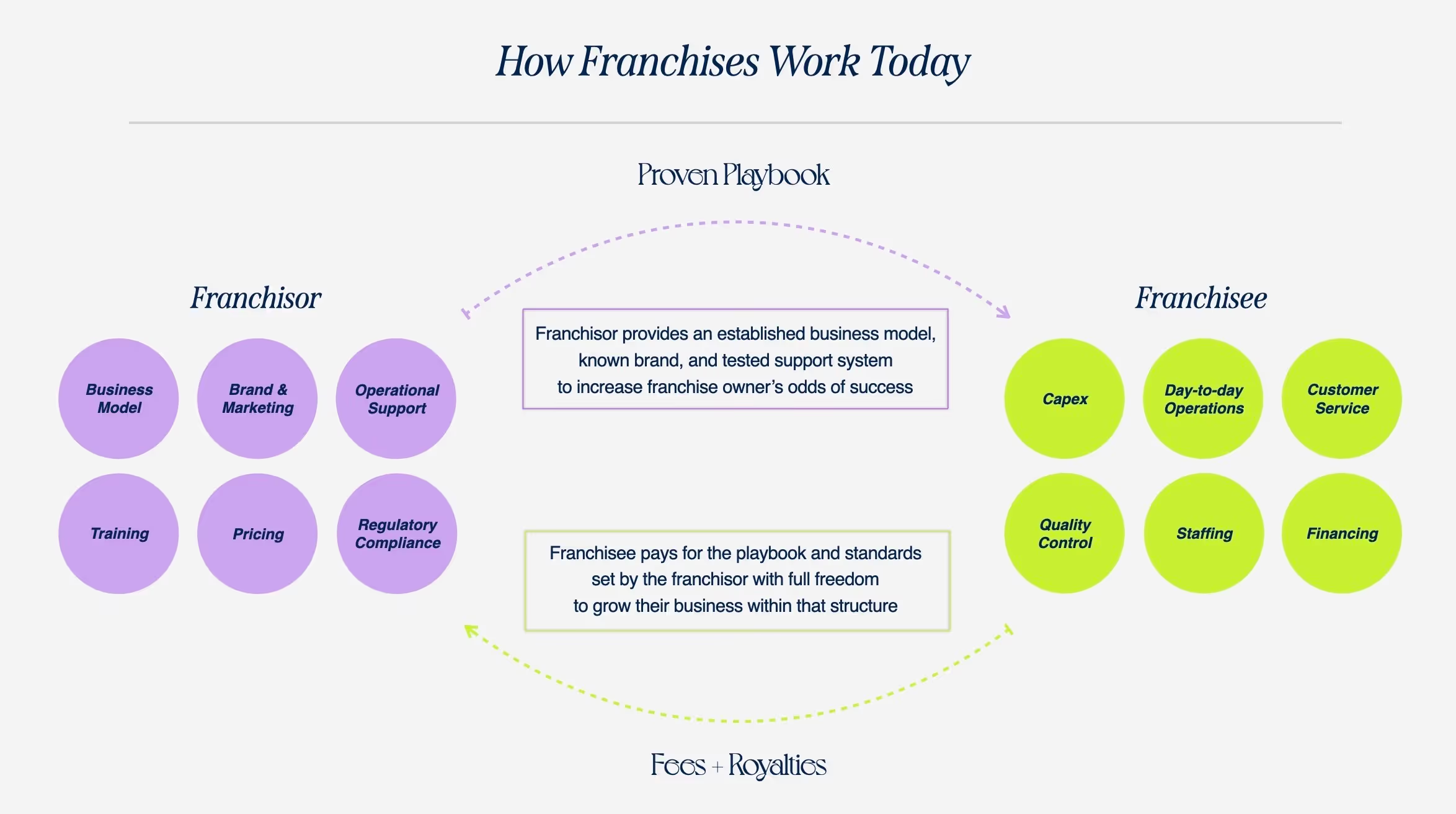Over the past decades, software-enabled business models have unlocked new opportunities for people to work for themselves. Labor marketplaces, like Uber and Doordash, have allowed people to set their own hours within a structured framework, while the rise of DIY software tooling has made it easier to start and manage independent businesses.
However, solopreneurs and SMBs have had to make major tradeoffs at either end of this spectrum. They can optimize for control of their business, but end up largely on their own. Or they can get assistance running it, which largely means one is beholden to the whims of the platform. This has also resulted in highly uneven value distribution between solo workers and the tech businesses that serve them. In the gig work model, workers often only capture a fraction of the value they create while the platform companies command significant take rates. Conversely, in the independent operation model, solopreneurs are largely on their own using DIY software tools. The risk is higher without any added structure or support, but if successfully leveraged, they can create outsized value for their business compared to what they pay the software company.
We propose a middle-ground, a play on the historic franchise model, but reinvented with digitally-native platforms where solopreneurs can grow their own businesses, but get software-driven tools, structure and support to drive success.
Revisiting the Franchise Business Model
What if there were a way for individuals to own and control their businesses, but also reap the benefits of scale marketing, supply chain and proven strategies? Well, it turns out this already exists in the analog world. You’ve probably heard about franchises as a way for business-savvy celebrities, like LeBron James or Sofia Vergara, to accumulate wealth, but you might not know how prevalent they are outside of these big names and, of course, outside of just restaurants. Businesses ranging from Great Clips to TrueValue Hardware to Century21 have all leveraged the franchise model to help grow.
Franchising has been an increasingly popular business model for many years and a major force in the American economy. It’s generally agreed that the franchise model first gained popularity in the US in the 1920s — A&W Root Beer is credited as the first true franchise business in the US and it became a tremendous success, expanding to 450 locations within 10 years.
Franchising has also become more prevalent than ever. According to a report on the US franchise industry by the International Franchise Association, there were a total of 775,000 franchise establishments in the US in 2021, employing about 8.2 million people. They contributed over $787 billion to the US economy in that same year.
How do Franchises work?
Franchises are the partnership between the Franchisor and the Franchisee. The franchisor creates a business model and brand that has been proven successful, then a franchisor licenses the rights to use this business model and brand for a fee, in addition to fees related to any necessary equipment or infrastructure to get started. This reduces risk to franchisees looking to start their own business.
The franchisee is expected to follow the franchisor's operating procedures in order to maintain the brand's reputation and consistency, but has the freedom to grow and run the business within the defined structure. Consistency becomes an important factor for consumers who are loyal to the franchise and expect a certain brand promise.
The franchise model works as follows:

The franchisor also provides ongoing support and training to the franchisee, and may assist with advertising and marketing efforts. By leveraging national campaigns and proven established structures, franchisees can collectively grow more strongly than they would on their own.
While franchisees are actively forgoing some autonomy, the playbook and assistance can make success more likely. Same thing for the franchisor. While they give up some level of local control, the empowered franchisee will likely have more passion for their own business than an employee or contractor would, bringing the grit and passion required for success.
Introducing Digitally-Native Franchises (DNFs)
Digital franchises share the benefits with their offline counterparts, but have a few distinctions:
- Marketing Automation: While all franchisors help with marketing, DNFs also focus on acquiring customers for their franchisees through digital channels. These tools provide SEO, keyword buying and look-alike targeting — at a greater investment than a solopreneur might achieve on their own. If needed, off-hours CX could be an option to ensure leads are processed quickly.
- Unified Platform: From CRM to e-commerce to workflow, DNFs provide one platform for their franchisees. This leverages both software best practices, while also reducing any need for integrations. Benchmarking and best practices can be built into the platform, so that standards are easier to meet.
- Financial Services: By centralizing payments, DNFs can understand the success of individual businesses. These insights give DNFs the ability to understand where franchisees are at with growth and provide cash advances to make that growth less of a burden on the franchisee.
- Online Community: Starting a business can be both lonely and challenging, but through the power of online community, DNFs can provide the peer-level support and guidance needed to be successful. Along the way, many franchisees can become amazing friends.
The Digital Franchise model differentiates itself from both gig work and independent operations by introducing aligned incentives and shared responsibility at its core. This is reflected across all aspects of the model — from the revenue model itself to operational support, product development, demand generation, and even brand strategy.

Many startups, flush with cash over the past decade, have opted to run local operations themselves by employing workers and purchasing physical assets off their own balance sheet. While there is a greater level of control, what would have been advantageous if these businesses were launched as digitally-native franchises?
What would have been different if Clutter worked with local people who wanted to own a storage business? What about Future working with local trainers already in the gyms frequented by potential customers? Could OneMedical have been more successful as a collection of private practices?
What are some examples of Digital Franchises?
While each market segment will have unique characteristics, DNFs all have flavors of the above characteristics. Let’s look at a few early examples:
- Alma Health: Alma is a mental health company that provides personalized care to clients through a network of therapists who offer both in-person and teletherapy services. Therapists benefit from Alma’s network of insurance payers, guaranteeing payment in two weeks with enhanced reimbursement rates and a cost estimator for clients. Therapists also receive access to Alma’s caseload management system and directory to find new clients. The community is a members-only platform to share resources, referrals and support. It also has workshops with industry experts and continuing education courses to help with credentialing.
- Fora Travel (a Forerunner portfolio company): Fora is a unified platform enabling anyone with a passion for travel to monetize that expertise as a modern travel agent. Unlike other travel agencies, Fora has a full-stack technology platform to make anything from collecting a credit card to publishing a blog post about the Riviera Maya as simple as a few clicks. Advisors receive training when they start and can participate in group trips with their peers to mix a little bit of discovery and fun at the same time. Instead of having to wait until payments are collected, advisors are promptly paid with one of the most favorable commission splits in the business, facilitated by the fact that Fora spends almost zero in end customer acquisition in a category known for massive marketing costs.
- Nana: Nana Appliance helps top appliance techs make more money by working for themselves. The platform qualifies jobs so that techs can focus on the work versus having to manage leads while being paid within 48 hours of the job. A unified technology platform enables techs to claim jobs, manage their schedule, and invoice customers from the palm of their hand. Master tech support can help on the trickiest jobs and the Nana community serves as a place to laugh about it later.
Just as Forerunner partnered with some of the earliest digitally-native brands, now collectively valued over $30 billion, we’re actively investing in digitally-native franchises and believe the potential could be even larger.
What categories are a good fit for the Digital Franchise model?
While many businesses could be digital franchises, there are certain categories where the model will enhance the experience for both business owner and end customer. With the right market characteristics, we believe this model will have greater success rates, sticking power and platform leverage, all critical to building an enduring company. These characteristics can be divided into three primary categories:
- Specialized Human Craft: The ideal categories for digital franchises typically fall into the bucket where consumers think of them as “I got a person for X,” such as personal trainers, handymen or tax advisors. While the services themselves might be commonplace, the person delivering them builds loyalty through consistent delivery and the occasional unexpected moment of surprise & delight. This leads to strong word of mouth customer acquisition. Sometimes special training or certification is required, which helps the service provider stand out, but can be more difficult to scale.
- Standardized Digital Workflow: While the entrepreneur provides the face of the business, an underlying technology platform ensures the foundation is solid and operations run smoothly. In order for this to be true, the workflow across end franchisees needs to be standardized and measurable. These traits enable the entrepreneur to onboard and service more customers and spend less nights and weekends managing the operational overhead.
- Integrated Platform Advantage: On top of standardized workflow, there are opportunities to add category-specific platform advantages that add an extra edge. These can be defensive tools like centralized regulatory approvals or offensive ones like integrated alternative payment methods. Some categories lend themselves to centralized services where the franchisee can either benefit from avoiding certain customer challenges or taking advantage of offerings to make money while they sleep and add even more value to customers.

Note that the least attractive categories in regards to Individual Characteristics — ridesharing and food delivery — have also been the most successful with the gig work model.
What’s next for DNFs?
The introduction of Digitally-Native Brands, through companies like Bonobos, Glossier & Warby Parker, set a new standard. By disaggregating retailers and leveraging new technology platforms like Shopify, these brands were able to establish a direct relationship with their customers. On the heels of social media, and the advertising platforms that accompanied them, new customers were easier to have personalized relationships with than ever before.
Digitally-Native Franchises have a similar opportunity for more service-first businesses. By fostering individual ownerships, DNFs play into the emerging trend to empower people to work for themselves. With the backdrop of AI advancements, digitally-native franchises can leverage a new tech stack ripe for automation, but with an increasingly human front end. And, just as online customer acquisition channels become more competitive and saturated, DNFs leverage something surprisingly old-school and capital-efficient: domain expertise and established trust within networks.
Just as Forerunner partnered with many of the earliest DNBs, now collectively valued over $30 billion, we’re actively investing in DNFs and believe the potential could be even larger. While the model is different, the need to understand the mindsets of your customers, both franchisees and their customers, remains critical. We’re actively looking to partner with founders and learn about others operating in this space. So please share thoughts and ideas because success here doesn’t just benefit those in the technology ecosystem, but the potentially millions of digitally-native franchisees looking for the purpose, community and financial empowerment inherent in the model.





.avif)


